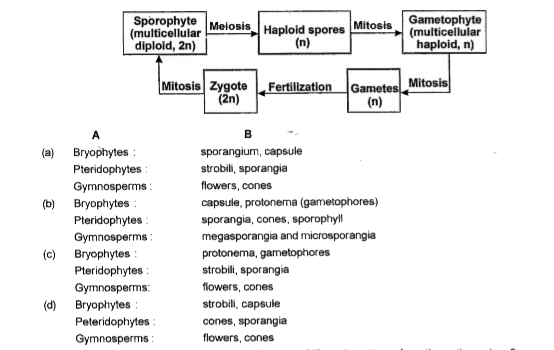Life cycle of seed plants is
Haplontic
Haplo-diplontic
Diplontic
Diplo-haplontic
The correct Answer is:C
Step-by-Step Solution:
1. Understanding Life Cycle Patterns:
- The life cycles of plants can be categorized into different patterns: haplontic, haplodiplontic, diplontic, and diplohaplontic. Each pattern describes the dominance of either the haploid (n) or diploid (2n) stages in the life cycle.
2. Identifying Seed Plants:
- Seed plants include Gymnosperms (which produce naked seeds) and Angiosperms (flowering plants that produce seeds within fruits).
3. Recognizing the Life Cycle of Seed Plants:
- Seed plants predominantly follow a Diplontic Life Cycle. In this cycle, the multicellular body is primarily the sporophyte, which is diploid (2n).
4. Meiosis in Sporophyte:
- In the diplontic life cycle, the sporophyte undergoes meiosis to produce haploid spores. These spores develop into gametophytes.
5. Formation of Gametes:
- The gametophytes produce gametes through a process called gametogenesis.
6. Fertilization:
- The fusion of male and female gametes occurs, resulting in the formation of a diploid zygote.
7. Development of New Sporophyte:
- The zygote then develops into a new sporophyte, completing the cycle.
8. Conclusion:
- Therefore, the life cycle of seed plants is classified as Diplontic.
Final Answer:
The life cycle of seed plants is Diplontic.
---
- The life cycles of plants can be categorized into different patterns: haplontic, haplodiplontic, diplontic, and diplohaplontic. Each pattern describes the dominance of either the haploid (n) or diploid (2n) stages in the life cycle.
- Seed plants include Gymnosperms (which produce naked seeds) and Angiosperms (flowering plants that produce seeds within fruits).
- Seed plants predominantly follow a Diplontic Life Cycle. In this cycle, the multicellular body is primarily the sporophyte, which is diploid (2n).
- In the diplontic life cycle, the sporophyte undergoes meiosis to produce haploid spores. These spores develop into gametophytes.
- The gametophytes produce gametes through a process called gametogenesis.
- The fusion of male and female gametes occurs, resulting in the formation of a diploid zygote.
- The zygote then develops into a new sporophyte, completing the cycle.
- Therefore, the life cycle of seed plants is classified as Diplontic.
The life cycle of seed plants is Diplontic.
Similar Questions
Knowledge Check
Part of plant which is important for the life cycle of plant is
AFruitBBudCFlowerDStemSelect the correct option w.r.t. chromosome number in the life cycle of rice plant.
AMegaspore mother cellNucellusMeiosporeEndosperm24242436BMegaspore mother cellNucellusMeiosporeEndosperm24241236CMegaspore mother cellNucellusMeiosporeEndosperm122412zeroDMegaspore mother cellNucellusMeiosporeEndosperm24242424Boron helps in life cycle of plant for
Aflower formationBseed germinationCpollen grain germinationDseed dormancy
Analyze the given life cycle of plants and select the plants which represent such a life cycle.

View SolutionWhat characters of seed plants make them specially adapted to life on land ?
View SolutionLife cycle of Lac insect.
View SolutionLife cycle is haplontic in
View SolutionThe gametophytic in the life cycle of a fern is
View Solution

